FDR with Cement Cuts Cost Over $1 Million
by John Arroyo, Executive Director, Northwest Cement Producers Group
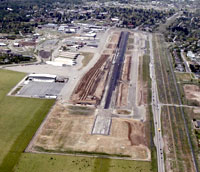 Central Idaho attracts a steady flow of visitors and new residents. The local airport in the town of Hailey, Idaho, relied on their consulting engineers, an experienced contractor, and a soil-cement specialist to rebuild their one and only runway in barely 30 days time. While some local airports shut down for twice that length of time, the Friedman Memorial Airport selected full-depth reclamation (FDR) with portland cement to meet a master plan objective and economically re-open for traffic in the shortest possible time span.
Central Idaho attracts a steady flow of visitors and new residents. The local airport in the town of Hailey, Idaho, relied on their consulting engineers, an experienced contractor, and a soil-cement specialist to rebuild their one and only runway in barely 30 days time. While some local airports shut down for twice that length of time, the Friedman Memorial Airport selected full-depth reclamation (FDR) with portland cement to meet a master plan objective and economically re-open for traffic in the shortest possible time span.
Background
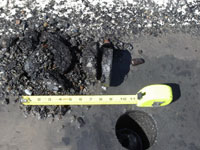 Project analysis began in the spring of 2006, nearly a year before actual runway construction work began. Toothman-Orton Engineering, a Boise-based civil engineering firm, discovered significant asphalt deterioration after core samples were taken. Like many flexible pavements, a number of asphalt layers were placed throughout the years. Twenty-three cores were cut out of the existing runway and 19 indicated that the asphalt was in worse condition than expected. Even though the top layer of asphalt was rated in decent shape, the lower layers had been subjected to a deterioration called asphalt stripping. Stripping is a common type of asphalt damage, caused when moisture and traffic loads cause the asphalt cement to separate (or strip) away from the aggregate. Airport management realized that a pavement problem existed that required their attention, monitoring and eventual action.
Project analysis began in the spring of 2006, nearly a year before actual runway construction work began. Toothman-Orton Engineering, a Boise-based civil engineering firm, discovered significant asphalt deterioration after core samples were taken. Like many flexible pavements, a number of asphalt layers were placed throughout the years. Twenty-three cores were cut out of the existing runway and 19 indicated that the asphalt was in worse condition than expected. Even though the top layer of asphalt was rated in decent shape, the lower layers had been subjected to a deterioration called asphalt stripping. Stripping is a common type of asphalt damage, caused when moisture and traffic loads cause the asphalt cement to separate (or strip) away from the aggregate. Airport management realized that a pavement problem existed that required their attention, monitoring and eventual action.
Airport Master Plan
The Blaine County vicinity attracts a steadily growing stream of visitors throughout the year. Hailey is the county seat and stepping off point for tourists (federal government land accounts for nearly 78 percent of Blaine County). Summer visitors exceed winter numbers even with Sun Valley ski resort nearby.
The county population grew by 7.3 percent between 2000 and 2002 and by 40.1 percent during the past decade when total employment grew by nearly 50 percent, from 12,099 jobs in 1990 to 17,556 jobs in 2000.
The four-season recreational area contributes to Friedman Airport’s needs to efficiently handle air traffic of all kinds. The airport projects traffic to grow 44 percent by 2022, the target date of their long-term master plan. Aircraft operations include all types of aircraft and are projected to increase from 57,888 in 2002 to around 83,800 in 2022. To meet this need, there is a strong likelihood that during the course of the next ten years or so a new airport will have to be opened to replace Friedman. Thus, there was no need for a complete runway reconstruction.
Diagnosis
The airport board, management staff and engineers initially thought that simply milling off some old asphalt and then adding an overlay would suffice for several years until the airport master plan could be implemented with a new facility. However, a more thorough pavement analysis proved useful. When the first group of cores alerted the experts to potential problems with asphalt stripping, Toothman-Orton then performed a further investigation with assistance from geotechnical engineers at Terracon, Inc. that confirmed that attention had to be given to the deteriorating underlying asphalt layers.
Constraints
Airports such as the one in Hailey have to minimize closure time. Airfield Operations Chief Pete Kramer says that their summer volume is busier than winter and that a long closure directly affects tourist, convention and conference traffic and local economy. Friedman Memorial management set a 30-day maximum construction time (runway shutdown) limit around which engineers and contractors had to complete the remedial pavement work. That critical parameter guided the consulting engineers as they evaluated their options.
Pavement Design Options
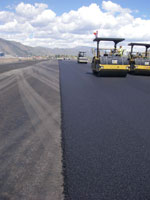 Based upon airplane traffic and underlying soils, engineers at first calculated three different asphalt-based pavement options. Concrete was not considered because longevity was not required because of the planned total airport replacement within the next ten years or so. A standard Federal Aviation Administration (FAA) design was considered along with two other pavement sections. When none of the first three could be constructed within a 30 day construction period engineers approached the FAA and requested consideration for full-depth reclamation. Full-depth reclamation (FDR) with cement is a pavement rehabilitation process where a failed asphalt pavement (surface and base) are pulverized, and then blended with cement and compacted. After curing, the cement-stabilized material forms a new base for the pavement, which is then surfaced to create a long-life pavement structure. After FAA engineering expressed willingness to consider FDR, an additional pavement option was developed with input from Boise-based Terracon.
Based upon airplane traffic and underlying soils, engineers at first calculated three different asphalt-based pavement options. Concrete was not considered because longevity was not required because of the planned total airport replacement within the next ten years or so. A standard Federal Aviation Administration (FAA) design was considered along with two other pavement sections. When none of the first three could be constructed within a 30 day construction period engineers approached the FAA and requested consideration for full-depth reclamation. Full-depth reclamation (FDR) with cement is a pavement rehabilitation process where a failed asphalt pavement (surface and base) are pulverized, and then blended with cement and compacted. After curing, the cement-stabilized material forms a new base for the pavement, which is then surfaced to create a long-life pavement structure. After FAA engineering expressed willingness to consider FDR, an additional pavement option was developed with input from Boise-based Terracon.
The four possibilities (three ordinary asphalt and one FDR) were: Full-depth reclamation with cement is a common practice among county road maintenance departments and state transportation departments. The process has different names in different states (such as CRAB in Idaho, which refers to cement recycled-asphalt base) but the end result is the same - rebuilding the pavement structure by recycling the existing materials and stabilizing with cement. FDR is environmentally friendly since it reuses materials on site, eliminating the need to haul them to a land-fill.
The usual option and alternatives #1 and #2 required roughly 45-50 days of runway downtime, outside the time frame established by Friedman Airport.
Dave Mitchell, of Toothman-Orton Engineers, said that “they had to find a way to perform the necessary work and get it done within the 30 days.” He was aware that the full-depth reclamation method to rehabilitate a failed asphalt roadway is used commonly by members of the Idaho Association of Highway Districts as well as by the Idaho Transportation Department (ITD) which has performed hundreds of miles of FDR with cement. Toothman-Orton Engineers enlisted the engineering expertise of Terracon who consulted on an FDR analysis and design so that the joint engineering effort could propose full-depth reclamation for an airport runway application. The parties also brought together a contractor and subcontractor experienced with pulverization and cement-stabilization of old asphalt pavements to gather input from those with construction experience. The proposed FDR approach cut 18 work days off the schedules of the other pavement options. In the case of Friedman Airport, a stronger base was not their objective, but it would result in reducing the thickness of the total pavement section, and accomplish the runway improvement within a short construction time period. Additionally, FDR allowed them to attain the 30-day goal in a sustainable fashion, as it recycles resources already in use and also eliminated “probably 4,000 truck trips that would have been a huge impact on the community”, Mitchell said.
Cost
The big surprise, said Toothman-Orton’s Mitchell, was that the consulting group’s advice to airport management to use full-depth reclamation would “cut their costs over a million dollars” when comparing all four possible pavement scenarios. Once the consultants proposed alternative #3 to FAA engineering and received FAA approval (federal airport funding was involved) and proposed the option to the five member airport commission and received their approval to proceed, the project went to bid in early 2007.
Construction
Low bidder Western Construction, Inc. from Boise, Idaho, mobilized earth-moving equipment in order to start immediately after Friedman Memorial Airport closed the runway on April 23, 2007. Despite some late snowfall the previous week, weather conditions cooperated with the schedule and the project was completed by the May 23, 2007 deadline.
 Western selected Valentine Surfacing from Vancouver, Washington, a company licensed in multiple states, to perform the actual FDR work on 73,440 square yards of runway. Approximately 6,900 feet of Hailey’s 7,500-foot airport runway had to be reworked. Chuck Valentine, president, recounted that his crew took “five days to grind and five days to mix” using two CMI pulverizing machines, a PR1200 and an RS800 along with a cement spreader truck and other typical grading equipment. A nominal 2 percent of portland cement was used at the start and was adjusted to the 2.3 percent level as construction proceeded to adjust for soil moisture.
Western selected Valentine Surfacing from Vancouver, Washington, a company licensed in multiple states, to perform the actual FDR work on 73,440 square yards of runway. Approximately 6,900 feet of Hailey’s 7,500-foot airport runway had to be reworked. Chuck Valentine, president, recounted that his crew took “five days to grind and five days to mix” using two CMI pulverizing machines, a PR1200 and an RS800 along with a cement spreader truck and other typical grading equipment. A nominal 2 percent of portland cement was used at the start and was adjusted to the 2.3 percent level as construction proceeded to adjust for soil moisture.
Precision Surveying and GPS Technology
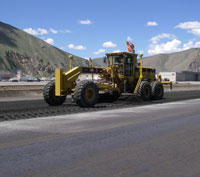 The FAA requires tight pavement surface precision on pavements, a plus or minus .02 foot allowance. Toothman-Orton required “robotic total station” in the specifications they wrote, using ITD specs as a starting point. Western Construction’s Jack Snyder commented that “we can build a better product without stakes” as he referred to the application of electronic grade control. Western combined dual methods on the Friedman Airport runway, electronic machine control as well as electronic grade control. He said they started using GPS about five years ago. Knowing that the FDR process is quick, requires precision the first time and that crews “can’t come back the next day,” Western Construction took dual precautions. They retained the services of Butler Engineering from Shelley, Idaho, to build terrain models with surveying data. Western also assigned experienced project engineer Marilyn Broek to the Hailey job along with four project superintendents.
The FAA requires tight pavement surface precision on pavements, a plus or minus .02 foot allowance. Toothman-Orton required “robotic total station” in the specifications they wrote, using ITD specs as a starting point. Western Construction’s Jack Snyder commented that “we can build a better product without stakes” as he referred to the application of electronic grade control. Western combined dual methods on the Friedman Airport runway, electronic machine control as well as electronic grade control. He said they started using GPS about five years ago. Knowing that the FDR process is quick, requires precision the first time and that crews “can’t come back the next day,” Western Construction took dual precautions. They retained the services of Butler Engineering from Shelley, Idaho, to build terrain models with surveying data. Western also assigned experienced project engineer Marilyn Broek to the Hailey job along with four project superintendents.
End Result
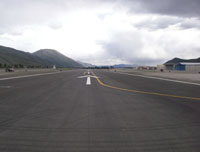 The project was successfully completed within the required 30-days. As a result, Airport Operations Chief Pete Kramer now recommends the FDR with cement process to other airport operators who want to minimize their runway reconstruction closure times to bare minimums. Western’s Snyder said that the successful completion depended on “the right technology and a ton of experience” brought to the table by the engineers involved and the construction team.
The project was successfully completed within the required 30-days. As a result, Airport Operations Chief Pete Kramer now recommends the FDR with cement process to other airport operators who want to minimize their runway reconstruction closure times to bare minimums. Western’s Snyder said that the successful completion depended on “the right technology and a ton of experience” brought to the table by the engineers involved and the construction team.